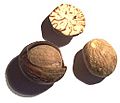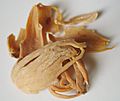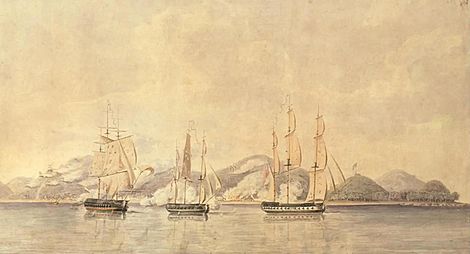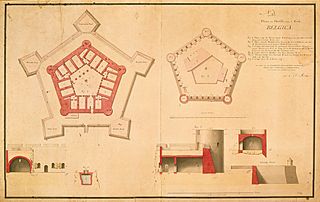Invasion of the Spice Islands facts for kids
Quick facts for kids Invasion of the Spice Islands |
|||||||||
|---|---|---|---|---|---|---|---|---|---|
| Part of the Napoleonic Wars | |||||||||
 View of the Island of Banda Neira – captured by a force landed from a squadron under the Command of Captain Cole in the morning of the 9th August 1810 |
|||||||||
|
|||||||||
| Belligerents | |||||||||
| Commanders and leaders | |||||||||
| Christopher Cole Edward Tucker |
Herman Willem Daendels R. Coop à Groen |
||||||||
| Strength | |||||||||
| 7 ships 1,000 soldiers and Marines |
various forts and coastal defences | ||||||||
| Casualties and losses | |||||||||
| light | all islands, fortifications and military stores captured | ||||||||
The invasion of the Spice Islands was a military attack by British forces. It happened between February and August 1810. The British aimed to take control of the Maluku Islands (also called the Moluccas or Spice Islands). These islands were owned by the Dutch in the Dutch East Indies. This invasion was part of the bigger Napoleonic Wars happening in Europe.
By 1810, the Kingdom of Holland was under the control of Napoleonic France. Great Britain and the East India Company wanted to control the rich Dutch spice islands. These islands were famous for valuable spices like nutmeg and cloves. Two British groups were sent. One group went to Ambon and Ternate. The other group attacked the more heavily defended islands of Banda Neira.
The campaign lasted seven months. British forces captured all the islands in the region. Ambon was taken in February. Banda Neira was captured in August. Ternate and other islands fell later that same month.
The British held onto the islands until the end of the war. After the Anglo-Dutch Treaty of 1814, the islands were given back to the Dutch. But during their time there, the East India Company had moved many spice trees. They replanted them in other parts of the British Empire.
Contents
Why the Spice Islands Were Important
The Moluccas were known as the Spice Islands because of special spices. These included nutmeg, mace, and cloves. These spices were only found there. This made European countries very interested in controlling the islands in the 1500s. Portugal was the first to control most of the spice trade.
The Dutch East India Company (VOC) arrived in 1599. They eventually pushed out the Portuguese. The English East India Company came soon after. They competed with the Dutch. This competition sometimes led to conflicts. In 1667, the Treaty of Breda helped calm things down. Both sides agreed to keep their current territories.
Later, the Dutch Republic became the Batavian Republic. It allied with Revolutionary France. The VOC then became a government company in 1796. During the wars that followed, the Dutch government asked the British to take over their colonies. This was to stop France from getting them. The Moluccas became part of the Dutch East Indies.
The British had to take the Dutch East Indies for a few reasons. First, they wanted to stop France from becoming too strong there. The East India Company was worried about its trade with China. Controlling the Spice Islands meant less trade for the Dutch. It also meant more valuable spice trade for the British company.
Getting Ready for the Invasion
| Maluku Island Spices |
|---|
|
|
In 1806, Herman Willem Daendels became the Dutch Governor-General in the East Indies. He worked to defend the region from the British. He used forced labor to make forts stronger. He also built a main road in Java to prepare for a British attack.
In 1809, the British Governor of India, Earl of Minto, planned to conquer the Moluccas. Two naval groups were prepared. The first group left in February 1810. Captain Edward Tucker led this group. It included ships like HMS Dover and HMS Cornwallis. They carried about 400 soldiers. Their main goal was to capture Ambon and Ternate.
The second group aimed to capture the Banda Islands. These islands were the center of the spice trade. The island of Banda Neira was very well defended. This group included ships like HMS Caroline and HMS Piedmontaise. Captain Christopher Cole commanded this group. They carried soldiers, sailors, and Royal Marines. They learned that over 700 Dutch troops might be in the Bandas.
The East India Company also sent agents. They wanted to see if they could move spice trees. They had done this on a small scale before. The main goal was to gain a commercial advantage. Taking the Spice Islands would hurt Dutch trade. It would also give the British company a rich new trade in spices.
Taking the Moluccas
Ambon Island Captured
The British force for Ambon left Madras on October 9, 1809. They arrived off Ambon in February 1810. Ambon was the most important Dutch Spice Island. On February 6, HMS Dover captured a Dutch warship. Both Dover and Cornwallis anchored near Ambon town. The town was protected by forts and batteries. The main fort was Fort Victoria.
The British attacked on February 16. Their ships fired cannons at the Dutch defenses. British troops, sailors, and marines landed quietly. They captured two batteries that overlooked the port and Fort Victoria. During the night, more men and cannons were landed. They joined the attack on Fort Victoria.
British cannon fire from ships and shore was very strong. Three Dutch ships in the harbor were sunk. The British then demanded that the Dutch Governor, Colonel Filz, surrender. After a few hours, he agreed. On February 18, the town surrendered. The British had very few casualties, only three dead. The entire island was defended by 250 Europeans and about 1,000 local soldiers. They all gave up their weapons.
During this campaign, the British captured several Dutch ships. One was the Dutch brig Mandurese. The British raised her after the surrender and used her. From Ambon, the British squadron went on to capture other islands. These included Saparua, Haruku, Nusa Laut, Buru, and Manipa.
After the attack on Ambon, Captain Spencer sailed to Pulo Ay in the Banda Islands. There, he captured Fort Revenge without a fight. Spencer made his ship look like a Dutch merchant vessel. This tricked the fort's commander, allowing Spencer to surprise them.
Later, Captain Tucker sailed to Gorontello on Celebes island in June 1810. The Dutch flag was flying, but a local Sultan ruled the area. Tucker convinced the Sultan to let the British take over from the Dutch. The Sultan agreed.
Finally, on June 26, HMS Dover captured the island of Manado. Fort Amsterdam there was protected by heavy batteries. The fort surrendered without a fight. Captain Tucker showed the Dutch Governor that his ship was ready to attack. Manado had a garrison of 113 men and 50 guns.
Banda Neira Taken
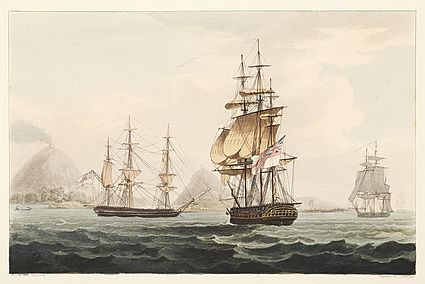
The British force for the Banda Islands arrived at Banda Neira on August 9. The main defense was Fort Belgica. This was a strong, star-shaped fort with a ditch around it. The older Fort Nassau was also nearby. The defenses had been made stronger since the British were last there. There were also ten other batteries. As predicted, there were 700 Dutch troops and 800 local soldiers.
The British plan was to approach Banda Neira after dark on August 8. They would land about 400 sailors, marines, and soldiers in small boats. These boats would enter the harbor before dawn. They hoped to surprise Fort Belgica and other strong points.
However, things did not go exactly as planned. The Dutch fired at them from a battery during the night. The weather also got worse, scattering the small boats. About 100 yards from shore, the boats got stuck on a coral reef. The men jumped into the water. After an hour and a half, before daylight, they landed in a sandy cove. When Captain Cole reached the meeting point, he had less than 200 men. He decided to continue the attack.
Commander Richard Kenah attacked a Dutch battery from behind. Using long poles, they captured about sixty men without firing a shot. Leaving a small guard, they tried to storm Fort Belgica twenty minutes later. As dawn broke, a local guide helped them to the outer walls of the fort. The British were spotted, and an alarm was raised. But heavy rain helped the attackers. The defenders could not see well, and their guns did not work.
The attackers used ladders to climb over the outer walls. They took this part of the fort. The inner walls were too high for their ladders. However, the main gate opened to let the fort's commander inside. The British quickly rushed in. By 5:30 AM, the fort was theirs. The Dutch lost their commander and ten men killed. Two officers and thirty men were captured, along with 52 cannons. The British had only a few men wounded.
Captain Cole sent Commander Kenah to demand the Dutch governor's surrender. While they talked, the British ships tried to enter the harbor. Dutch batteries fired at them. The British used the guns of Fort Belgica to fire back. They threatened to destroy the nearby town if the governor did not surrender. He then agreed.
Ternate Falls
The final part of the campaign was to capture Ternate. This was the last important Dutch possession in the Moluccas. After taking Manado, Captain Tucker and 174 men arrived there on August 25. The plan was to capture Fort Kalamata, a small fort near the main town. The main town had Fort Oranje, a bigger fort. This fort had 92 heavy guns and 500 men. Many of the local soldiers were unhappy about their pay.
Tucker and his men landed in daylight on August 28. They climbed a hill and placed a field gun there. The area was thick with forest. Tucker tried a night march. They met a roadblock. A detour led to a fight with a strong Dutch group. After pushing the Dutch away, they found a beach near Fort Kalamata. The Dutch opened fire. Even so, the British decided to attack. They crossed a ditch and stormed the fort using ladders. They captured it after some fighting. The British had three killed and fourteen wounded.
Tucker demanded that the Dutch governor, Colonel Jon van Mithman, surrender. But guns from Fort Kota Baro fired at the British ships. HMS Dover moved in front of it and silenced the battery. A small group then took the fort by surprise. Dover then attacked Fort Oranje. The Dutch fought back for a few hours. But the fort was badly damaged, and they had many losses. A group of Royal Marines then attacked Fort Oranje from behind. The British turned both fort guns on the town. Dover also fired at the town. By 5 AM, the Dutch gave up.
The day after the town surrendered, Mithman surrendered the island to the British. By August 31, the campaign in the Moluccas was over.
What Happened Next
After the Dutch surrendered, Captain Charles Foote was made Lieutenant-Governor of the Banda Islands. This victory helped set the stage for Britain's invasion of Java in 1811. Captain Cole also helped plan and carry out that invasion. For his services, Cole was knighted in May 1812. He also received a special medal and an honorary degree.
Before the Dutch got the islands back, the East India Company gathered spice seedlings. They started moving spice trees on a large scale. Most were sent to Bencoolen and Penang. Others went to Ceylon and other British colonies. In the 1790s, the company had already started spice gardens in Penang. By 1805, these had 5,100 nutmeg trees and 15,000 clove trees. After the 1815 occupation, these numbers jumped to 13,000 nutmeg trees and 20,000 clove trees. From these places, the trees were moved to other British colonies. This included Grenada and later Zanzibar. This competition greatly reduced the value of the Banda Islands for the Dutch.
The Anglo-Dutch Treaty of 1814 gave the islands and Java back to the Dutch. The islands remained part of the Dutch East Indies. They were a colony of the Kingdom of the Netherlands until Indonesia became independent in 1945.
See also
- Pattimura




